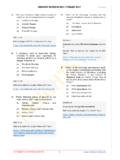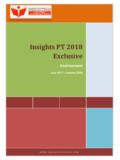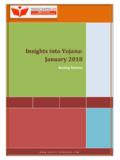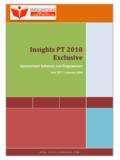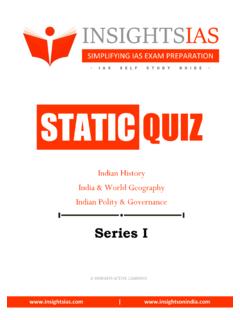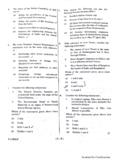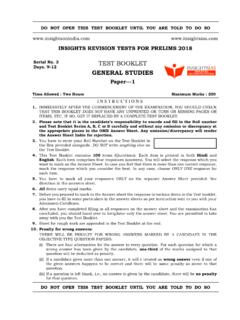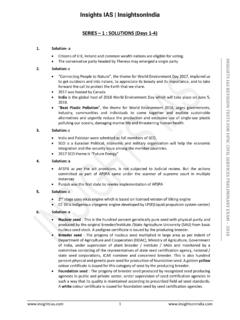Transcription of 9A
1 IPC sections (375-377) which criminalises rape. Post Nirbhaya gang rape, Government in 2013 made certain amendments to IPC. It added acts like acid attacks, stalking, sexual harassment, etc., in the IPC. It also added death penalty for certain categories of rapes and repeat offenders. Statutory provisions for women Maternity benefits act, 2016. 1. The Maternity Benefit is the one which protects the employment of women during the time of her maternity and entitles her full paid absence from work, to take care for her child. 2. The State to make any special provision in favour of women and children (Article 15 (3)). The State to make provision for securing just and humane conditions of work and for maternity relief (Article 42).
2 Surrogacy bill, 2016. Marital Rape 1. Marital rape can be defined as sexual intercourse with legally wedded partner without his/her consent. Marital rape represents a stark reality of the domestic violence against the women. 2. Why should it be criminalised 1. According to National Family Heath Survey (NFHS) of all the women who have faced sexual violence, 93% had experienced this at the hands of their spouses. 2. Forceful sexual intercourse leads to subjugation of women to men's authority which is against the principle of equality under article 14 and article 21 of Indian constitution. It further leads to domestic violence. 3. It causes severe damage to genital organs which can be categorised as violence.
3 4. It will strengthen our commitment for Convention on the Elimination of All Forms of Discrimination against Women (CEDAW) and removing inequality which is one of the SDG. goal. 5. The Justice JS Verma committee while dealing the criminal law amendment act has also suggested that marital rape be made a non-bailable offence. 6. The law commission in its 172nd report following the SC. directives in Sakshi Vs Union of India (2004) said that forceful sex without wife's consent is an offence just as any physical violence and should be punished. 7. This will help to change patriarchal mindset of our society, where women are treated as second class citizens. 8. Countries like USA, UK, Malaysia, Turkey etc.
4 , have already criminalised it and as a progressive democracy, India must legislate to enhance the confidence in women. 3. Roadblocks 1. Proponents of the marital rape exception, however, argue that it is essential to preserve the integrity of marriage, which is a crucial social institution. 2. There is possibility of misuse of the penal provisions as has been the case with 498A, and the Dowry (Prohibition) Act. 3. Before taking any step towards criminalising marital rape there needs to be proper well defined lines and definitions for what is marital rape and what is non-rape'. 4. Difficulty in implementation due to various factors like illiteracy, poverty, social customs and values, etc.
5 5. Lack of infrastructure, resources and judicial impact assessment would lead to burgeoning of pendency of cases. 4. This country has its own unique problems due to various factors like literacy, lack of financial empowerment of the majority of females, mindset of the society, vast diversity, poverty, etc. these should be considered carefully before criminalising marital rape. Sexual offenders registry Triple Talaq Sabarimala Judgement 1. Essential religious practises: Judiciary has relied upon a particular jurisprudence that it has carved itself to determine which rituals and beliefs deserve special constitutional protection. However, SC in Shirur Matt case has held that what constitutes an essential part of a religion must be determined with reference to the doctrines of that religion.
6 It is a judge centric approach. 2. Essential religious practises cases 1. HC said santhara is not essential religious practise. But SC over ruled it. 2. Sabarimala case. 3. A 650 km Women's wall was formed in Kerala to uphold gender equality and protest against gender discrimination in Women entry to Sabarimala. 4. CEDAW states that the states which are signatory to the convention must ensure that principle of equality for men and women are incorporated in their legal system and all the discriminatory laws abolished. Right to marry Female labour participation rate 1. The share of women in India's workforce has fallen dramatically . from about 35% to since 1990s. This is all the more surprising because this was a period of high GDP and employment growth.
7 While some of the fall in women's workforce participation is explained by higher rates of higher education enrolment, indicating that more young women are in higher education rather than working or looking for jobs, the data also points to a fall in working rates for older women. 2. Reasons for low female LFPR. 1. Patriarchal mindset: Still women are considered best to work as housewife and for providing supplementary income in time of distress but not as regular workers. 2. Education: Low enrolment in primary and higher eduction which is made worse by high dropout ratio. 3. Agriculture: Most of the women are dependent on agriculture sector. Mechanisation of agriculture has led to losing out on jobs for women.
8 4. Security: Lack of due diligence on part of government to provide night time security, public transport at night, cctv cameras, etc. Still Vishakha guidelines has not got statutory status. 5. Lack of good jobs: Women have multiple responsibilities, so provision of working from home, maternity leaves, creche facilities at the workplace are lacking. 3. Measures 1. Creating awareness against unconscious and conscious gender biases. Creating and celebrating female role models, encouraging women employees to do better. 2. Economic empowerment by boosting SHGs, Kudumbashree type programs etc. Using technology to develop entrepreneurial spirit among women will also improve the empowerment of women.
9 3. Skill India Mission goal should center around women education, vocational training etc. Make in India initiative should promote women participation to ensure manufacturing growth coincide with women's growth. Government should promote women led MSMEs through the MUDRA scheme, granting entrepreneurial loans at concessional rate. 4. There is need to make women the owner of capital, be it land given under government rehabilitation policy, loan given at subsidised rates, bank account created under Jan Dhan Yojana etc. 5. Giving financial incentives to firms who employ more women than national average. Ensure safety at workplace by complying Vishakha guidelines, etc. 6.
10 Most important is political empowerment by 1/3rd reservations in Parliament and State legislatures and health aspects of women like maternity, etc. 4. The NITI Ayoog 75 years strategy document aims to achieve a female labour force participation of at least 30 percent by 2022. Post- independence, the women movements like anti-liqour movements, SHG. revolution, strong legislations like Domestic Violence Act, PCPNDT act etc., governmental schemes like BBBP and recent MeToo movement has impacted the women in the lower strata in a positive way. 5. Vishakha guidelines 1. Set up an internal committee. There should be an internal compliant grievance committee when workplace is of more than 10 employees.

